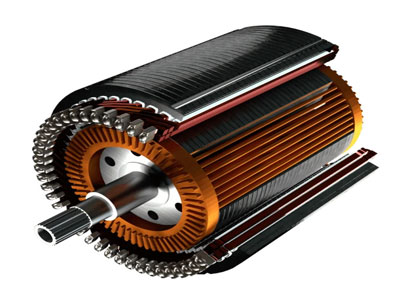Key Takeaway
An asynchronous motor, also known as an induction motor, is an AC motor where the rotor does not rotate at the same speed as the magnetic field created by the stator. This difference in speed, known as “slip,” is essential for the motor’s operation. The slip allows the rotor to generate the necessary torque through electromagnetic induction without needing direct electrical connections.
Asynchronous motors are widely used due to their simplicity, durability, and ability to handle varying loads efficiently. They are commonly found in industrial applications such as pumps, fans, and conveyor systems, where their robust design and low maintenance make them a preferred choice.
The Basic Concept of Asynchronous Motors
An asynchronous motor, often referred to as an induction motor, is a type of electric motor that operates without the rotor being synchronized with the magnetic field produced by the stator. This motor is one of the most widely used in various industries due to its simplicity, durability, and cost-effectiveness. At its core, the asynchronous motor works by inducing a current in the rotor through electromagnetic induction, rather than through a direct electrical connection. This induction occurs because the rotor is placed within a rotating magnetic field created by alternating current (AC) in the stator windings. The difference in speed between the rotor and the magnetic field—known as slip—is what allows the motor to generate torque. Understanding this basic concept is crucial for anyone working with electric motors, especially in industrial settings.

How Asynchronous Motors Operate Without Synchronization
Asynchronous motors operate on the principle of electromagnetic induction, where the current in the rotor is induced by the magnetic field of the stator. When alternating current (AC) flows through the stator windings, it creates a rotating magnetic field. The rotor, which is typically made of conductive material like aluminum or copper, is placed within this field. As the magnetic field rotates, it induces a current in the rotor, causing it to spin. However, unlike synchronous motors, the rotor in an asynchronous motor does not rotate at the same speed as the stator’s magnetic field. This difference, known as slip, is crucial for torque generation and is what makes the motor “asynchronous.” The ability to operate without perfect synchronization allows these motors to handle varying loads effectively, which is a key advantage in many industrial applications.
Comparison Between Asynchronous and Synchronous Motors
When comparing asynchronous motors to synchronous motors, several key differences come to light. The most obvious difference is in their operating principles. Synchronous motors rotate at a speed that is precisely in sync with the frequency of the supply current, meaning there is no slip between the rotor and the stator’s magnetic field. In contrast, asynchronous motors always operate with some degree of slip, which allows them to generate torque.
Another important distinction lies in their applications and efficiency. Synchronous motors are often used in applications where precise speed control is necessary, such as in clocks or timing devices. Asynchronous motors, on the other hand, are more commonly used in situations where robustness and simplicity are more important than precision, such as in pumps, fans, and conveyor systems. Additionally, asynchronous motors tend to be more cost-effective and easier to maintain, making them a preferred choice for many industrial uses.
The Importance of Slip in Asynchronous Motors
Slip is a fundamental concept in the operation of asynchronous motors and is key to understanding how they function. Slip is defined as the difference between the speed of the stator’s magnetic field and the actual speed of the rotor. Without slip, the rotor would not experience the relative motion needed to induce current, and as a result, no torque would be generated.
In practical terms, slip allows asynchronous motors to adjust their performance based on the load they are driving. For example, when an asynchronous motor encounters an increased load, the slip increases, which in turn increases the torque output, allowing the motor to handle the load without stalling. This self-regulating feature is one of the reasons why asynchronous motors are so widely used in applications where varying loads are common. Engineers must understand the concept of slip to design systems that can take full advantage of the motor’s capabilities.
Practical Applications of Asynchronous Motors
Asynchronous motors are incredibly versatile and find applications across a wide range of industries. In manufacturing, these motors are often used to drive machinery such as conveyor belts, pumps, and fans, where their ability to handle heavy loads and operate continuously is crucial. Their robustness makes them ideal for use in harsh environments, such as in mining or oil and gas extraction, where equipment reliability is paramount.
In consumer applications, asynchronous motors power everyday appliances like washing machines, air conditioners, and refrigerators. Their energy efficiency and low maintenance requirements make them an excellent choice for these devices, where long-term reliability and cost-effectiveness are important considerations. Additionally, asynchronous motors are increasingly being used in renewable energy applications, such as wind turbines, where their ability to operate under varying conditions is highly valued.
Conclusion
Asynchronous motors are a cornerstone of modern industry and daily life, offering a unique combination of simplicity, reliability, and adaptability. The concept of slip, which differentiates asynchronous motors from their synchronous counterparts, is central to their operation and provides the flexibility needed to handle varying loads. Whether in industrial machinery, household appliances, or renewable energy systems, asynchronous motors play a critical role in powering the world around us. For engineers, a deep understanding of these motors is essential for designing efficient and effective systems across a wide range of applications. As technology continues to evolve, the importance of asynchronous motors is likely to grow, further solidifying their place in the pantheon of essential engineering tools.
